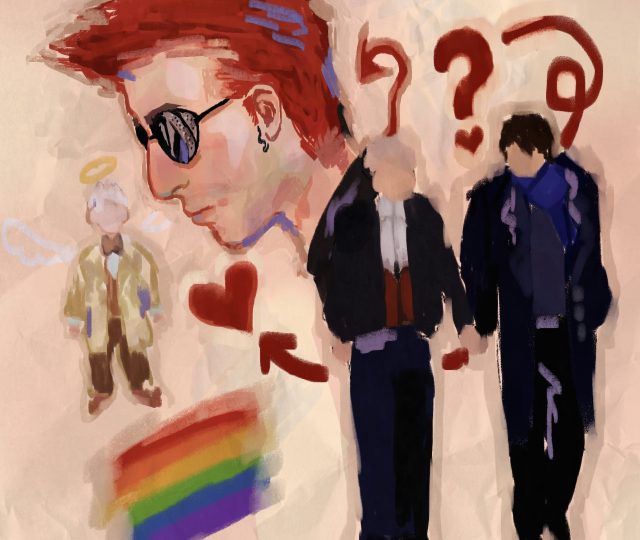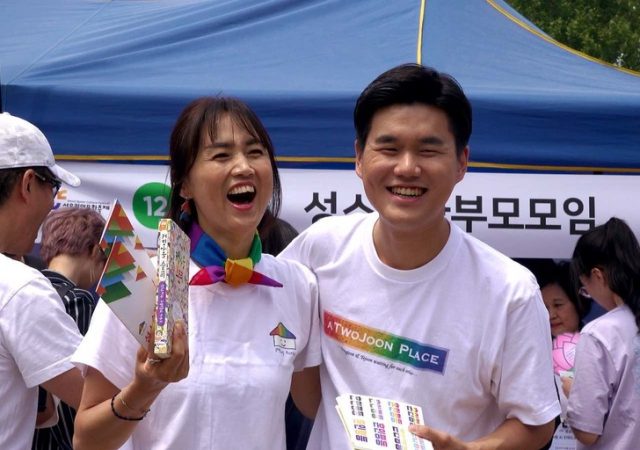On Nov. 9 and 10, 2024, Enzo Camacho and Ami Lien screened their newest experimental labor-activist documentary, Langit Lupa (Heaven and Earth) (2023), at 2220 Arts + Archives in Historic Filipinotown. The documentary braids personal testimonies from survivors of the violent Escalante Massacre with vivid phytograms taken from a sugar plantation in Negros, Philippines, raw 16 mm film, and theatrical performances by Escalante children. The weekend screenings and related programs were part of Camacho and Lien’s artist residency with Active Cultures, a public arts nonprofit in Los Angeles that explores the intersection of art, food, and ecologies through artist-led projects and programs.
Film
Queerbaiting to Queer Couples: The Evolution of Queerness in 21st Century Media
2023 has truly been a great year for LGBTQ+ representation in media. From movies like “Bottoms” to TV shows like “Heartstopper” and “Good Omens,” we are living in the very recent development of what Them calls “a golden era for LGBTQ+ representation.”
“Glen or Glenda”: Feeling Seen Through Art
“Glen or Glenda” is a 1953 transgender exploitation film directed by Ed Wood. It was made incredibly cheaply and quickly and is full of out-of-date ideas and terms about gender and transitioning, with film critic Leonard Maltin describing it in his 2004 movie & video guide as “possibly the worst movie ever made.” That being said, as a transgender woman, I have never felt more seen while watching a film than while watching “Glen or Glenda.” The movie’s critical panning has held it from the fruitful examination it deserves due to its radical stance on gender as it relates to the self and society.
What “Red, White & Royal Blue” Gets Right About Being Queer in Politics — And What It Doesn’t
“I am the First Son of the United States, and I’m bisexual. History will remember us.”
Casey McQuiston’s debut romance novel “Red, White & Royal Blue” has recently been adapted into an Amazon Prime movie, bringing the love story between the American First Son and the Prince of England to the big screen. The film is a winding tale of controversy and copulation, but ends happily with Alex Claremont-Diaz (played by Taylor Zakhar Perez) and Henry Windsor (played by Nicholas Galitzine) stepping into Alex’s childhood home to start the next chapter of their lives together.
Queer Summer 2023 Favorites
Our OutWrite staff loves queer media! Here are some of our favorites from this summer:
Gay Wrongs, and Why I Support Them — On “Bottoms” and Queer Irreverence
Lesbians have never looked as hot as when they are covered in the blood of football jocks like the characters of “Bottoms,” the instant classic lesbian rom-com movie of the year. “Bottoms” — directed by Emma Seligman — follows Josie (Ayo Edebiri) and PJ’s (Rachel Sennott) attempt to woo their respective love interests, Isabel (Havana Rose Liu) and Brittany (Kaia Gerber), with a faux all-women’s self-defense fight club. The film screams of a dark humor and irreverence rarely seen in LGBTQ+ media — a refreshing new take that presents audiences with queer, gray morality, or what I lovingly call ‘Gay Wrongs’.
Araki and the Apocalypse
It’s not every day that your new gay crush climbs through your window, confesses their love, and then promptly explodes in a shower of blood “Alien” style, leaving behind a cockroach-like extraterrestrial. But it happens in Gregg Araki’s surrealist sextravaganza “Nowhere.”
To Walk A Mile in Her Shoes You Must First Wear Her Skin
The horror genre has a transphobia problem. I’m an avid horror fan whose apartment requires a warning to enter with all the horror villains plastered to my walls. I am also a transgender person who knows that negative depictions of my community, however unintentionally harmful, do have an impact. To understand these consequences, I will be discussing four horror films that feature transmisogynist tropes and explore how their portrayal causes real harm to the trans community.
Being My Mother’s Son: A Review of Queer Korean Documentary “Coming to You”
On May 5, 2023, UCLA screened “Coming to You” (“한글: 너에게 가는 길”) directed by Gyu-ri Byun (she/her), a groundbreaking Korean documentary about the mothers of queer adults in Korea. The documentary centers on the mothers, Nabi (she/her) and Vivian (she/her), who are members of PFLAG Korea (Parents, Families and Allies of LGBTAIQ+ People in Korea). Both women are cisgender and heterosexual. Prior to their children coming out to them, they held little to no knowledge about the queer community and harbored discriminatory opinions about queerness. Nonetheless, the documentary made no excuses for their past queerphobia and followed their journeys into wholehearted queer activism.
Queers Kill Cats, Too: A Review of “Gummo”
Harmony Korine’s 1997 directorial debut “Gummo” is one of those movies that gets swallowed up by its own images. More than any plot event, people remember “Gummo” for the bathtub spaghetti scene, the Bunny Boy’s hat, and the unique shape of Jacob Reynold’s head as Solomon on the film’s box art. This is strange, though, considering that the film itself aspires to be so much more. Revisiting “Gummo,” it reads as an attempt to address as many social and political issues as possible by slotting them into the film’s Midwestern setting. Over the course of its runtime, “Gummo” explores themes ranging from sexual assault to racism to misogyny to ableism and eventually to homophobia, transphobia, and beyond, all to wildly varying degrees of success.













